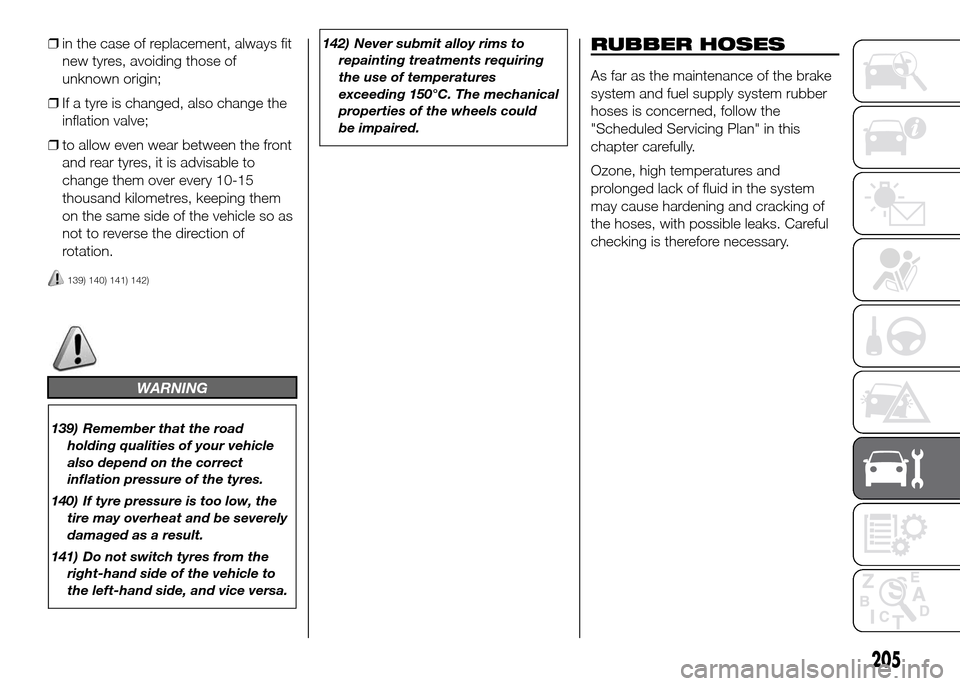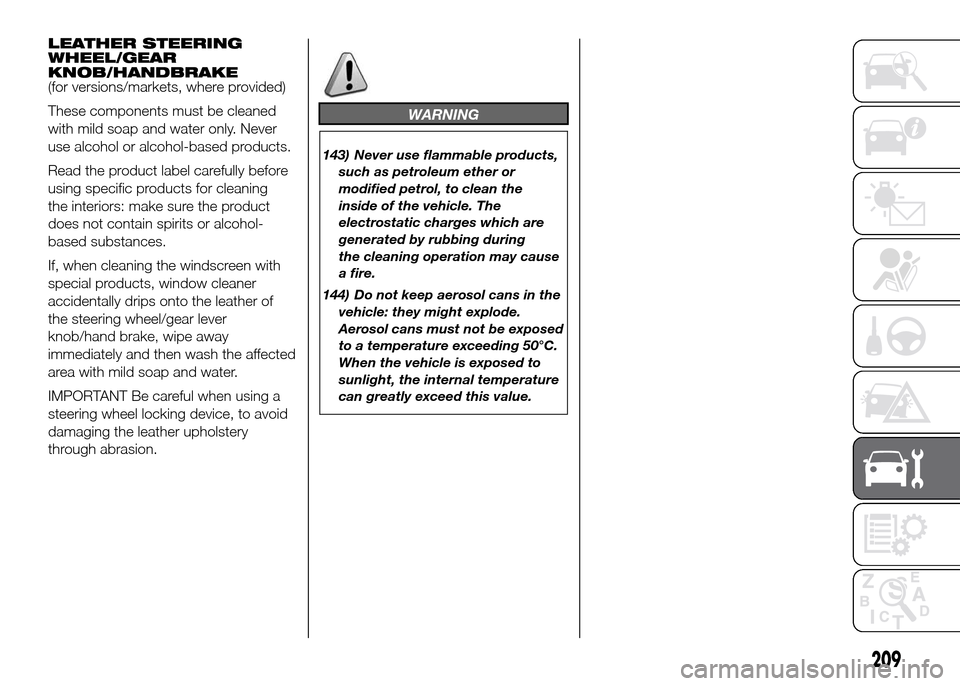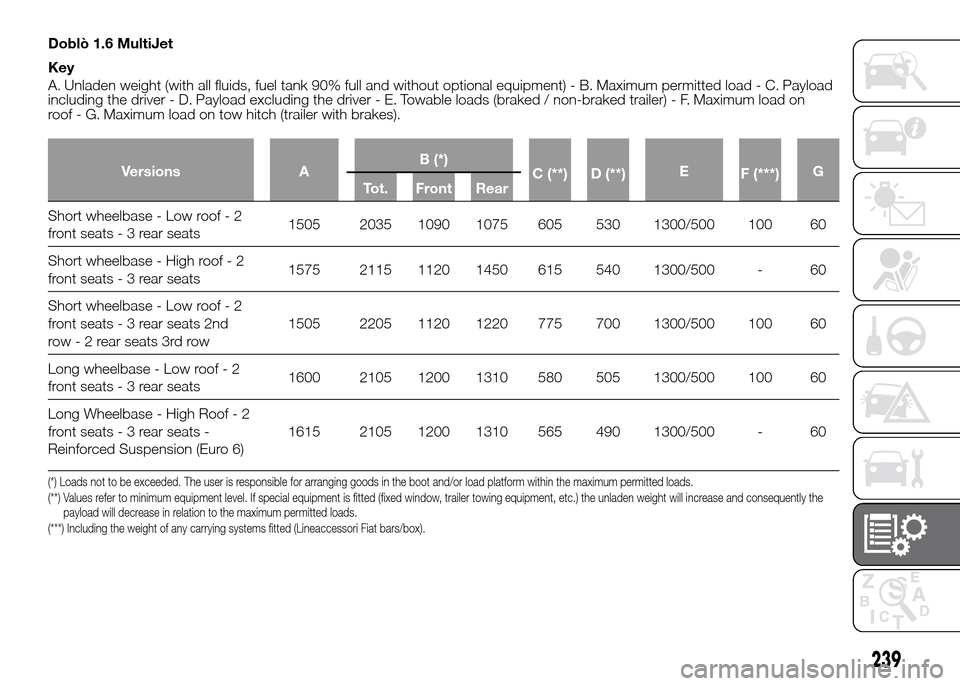Page 209 of 323

❒in the case of replacement, always fit
new tyres, avoiding those of
unknown origin;
❒If a tyre is changed, also change the
inflation valve;
❒to allow even wear between the front
and rear tyres, it is advisable to
change them over every 10-15
thousand kilometres, keeping them
on the same side of the vehicle so as
not to reverse the direction of
rotation.
139) 140) 141) 142)
WARNING
139) Remember that the road
holding qualities of your vehicle
also depend on the correct
inflation pressure of the tyres.
140) If tyre pressure is too low, the
tire may overheat and be severely
damaged as a result.
141) Do not switch tyres from the
righthand side of the vehicle to
the lefthand side, and vice versa.142) Never submit alloy rims to
repainting treatments requiring
the use of temperatures
exceeding 150°C. The mechanical
properties of the wheels could
be impaired.
RUBBER HOSES
As far as the maintenance of the brake
system and fuel supply system rubber
hoses is concerned, follow the
"Scheduled Servicing Plan" in this
chapter carefully.
Ozone, high temperatures and
prolonged lack of fluid in the system
may cause hardening and cracking of
the hoses, with possible leaks. Careful
checking is therefore necessary.
205
Page 210 of 323

PROLONGED
VEHICLE INACTIVITY
If the vehicle needs to be off the road
for longer than one month, the following
precautions must be taken:
❒park the vehicle indoors in a dry and,
if possible, well-ventilated place;
❒engage a gear and check that the
handbrake is not engaged;
❒disconnect the negative terminal from
the battery pole (see paragraph
“Vehicle inactivity” in the "Dashboard
and controls" chapter) and check
the charge conditions (see paragraph
“Battery” in the “Care and
maintenance” chapter);
❒clean and protect the painted parts
using protective wax;
❒clean and protect the shiny metal
parts using special compounds
available commercially;
❒sprinkle talcum powder on the
windscreen and rear window wiper
rubber blades and lift them off the
glass;
❒slightly open the windows;❒cover the vehicle with a piece of
fabric or perforated plastic sheet. Do
not use compact plastic tarpaulins,
which prevent humidity from
evaporating from the surface of the
vehicle;
❒inflate tyres to +0.5 bar above the
standard specified pressure and
check it at intervals;
❒do not drain the engine cooling
system.
BODYWORK
PROTECTION AGAINST
ATMOSPHERIC AGENTS
The main causes of corrosion are the
following:
❒atmospheric pollution;
❒salty air and humidity (coastal areas,
or hot humid climates);
❒seasonal environmental conditions.
The abrasive action of wind-borne
atmospheric dust and sand, as well as
mud and gravel raised by other cars
is also not to be underestimated.
On your vehicle, Fiat has implemented
the best manufacturing technologies
to effectively protect the bodywork
against corrosion.
These include:
❒painting products and systems which
give the vehicle particular resistance
to corrosion and abrasion;
❒use of galvanised (or pretreated)
sheet metal, with high resistance
to corrosion;
❒spraying the underbody, engine
compartment, wheelhouse internal
parts and other parts with highly
protective wax products;
206
SERVICING AND MAINTENANCE
Page 213 of 323

LEATHER STEERING
WHEEL/GEAR
KNOB/HANDBRAKE
(for versions/markets, where provided)
These components must be cleaned
with mild soap and water only. Never
use alcohol or alcohol-based products.
Read the product label carefully before
using specific products for cleaning
the interiors: make sure the product
does not contain spirits or alcohol-
based substances.
If, when cleaning the windscreen with
special products, window cleaner
accidentally drips onto the leather of
the steering wheel/gear lever
knob/hand brake, wipe away
immediately and then wash the affected
area with mild soap and water.
IMPORTANT Be careful when using a
steering wheel locking device, to avoid
damaging the leather upholstery
through abrasion.
WARNING
143) Never use flammable products,
such as petroleum ether or
modified petrol, to clean the
inside of the vehicle. The
electrostatic charges which are
generated by rubbing during
the cleaning operation may cause
a fire.
144) Do not keep aerosol cans in the
vehicle: they might explode.
Aerosol cans must not be exposed
to a temperature exceeding 50°C.
When the vehicle is exposed to
sunlight, the internal temperature
can greatly exceed this value.
209
Page 215 of 323

TECHNICAL SPECIFICATIONS
Everything you may find useful for
understanding how your vehicle
is made and works is contained in this
chapter and illustrated with data, tables
and graphics. For the enthusiasts and
the technician, but also just for those
who want to know every detail of their
vehicle.IDENTIFICATION DATA....................212
ENGINE CODES - BODYWORK
VERSIONS ......................................214
ENGINE ..........................................216
SUPPLY ..........................................219
TRANSMISSION .............................220
BRAKES .........................................221
SUSPENSION .................................222
STEERING ......................................223
WHEELS .........................................224
DIMENSIONS ..................................231
WEIGHTS........................................237
SUPPLIES .......................................264
FLUIDS AND LUBRICANTS ............266
PERFORMANCE .............................269
FUEL CONSUMPTION ....................270
CO2 EMISSIONS ............................290
OFFICIAL TYPE APPROVALS .........302
PRESCRIPTIONS FOR HANDLING
THE VEHICLE AT THE END OF ITS
LIFE ................................................305
211
Page 225 of 323
BRAKES
Front service brakes Rear service brakes Parking brake
self-ventilated discs discscontrolled by hand lever, working on rear
brakes
IMPORTANT Water, ice and salt spread on the roads may deposit on the brake discs reducing braking efficiency the first time
the brakes are applied.
221
Page 241 of 323

WEIGHTS
Doblò 1.4
Key
A. Unladen weight (with all fluids, fuel tank 90% full and without optional equipment) - B. Maximum permitted load - C. Payload
including the driver - D. Payload excluding the driver - E. Towable loads (braked / non-braked trailer) - F. Maximum load on
roof - G. Maximum load on tow hitch (trailer with brakes).
Versions AB (*)
C (**) D (**)E
F (***)G
Tot. Front Rear
Short wheelbase - Low roof - 2
front seats-3rearseats1445 1945 1090 1140 605 530 1000/500 100 60
Short wheelbase - High roof - 2
front seats-3rearseats1505 2045 1120 1450 615 540 1000/500 - 60
Short wheelbase - Low roof - 2
front seats-3rearseats 2nd
row-2rearseats 3rd row1445 2145 1120 1220 775 700 1000/500 100 60
(*) Loads not to be exceeded. The user is responsible for arranging goods in the boot and/or load platform within the maximum permitted loads.
(**) Values refer to minimum equipment level. If special equipment is fitted (fixed window, trailer towing equipment, etc.) the unladen weight will increase and consequently the
payload will decrease in relation to the maximum permitted loads.
(***) Including the weight of any carrying systems fitted (Lineaccessori Fiat bars/box).
237
Page 242 of 323

Doblò 1.4 T-JET
Key
A. Unladen weight (with all fluids, fuel tank 90% full and without optional equipment) - B. Maximum permitted load - C. Payload
including the driver - D. Payload excluding the driver - E. Towable loads (braked / non-braked trailer) - F. Maximum load on
roof - G. Maximum load on tow hitch (trailer with brakes).
Versions AB (*)
C (**) D (**)E
F (***)G
Tot. Front Rear
Short wheelbase - Low roof - 2
front seats-3rearseats1490 2030 1090 1140 615 540 1000/500 100 60
Short wheelbase - Low roof - 2
front seats-3rearseats 2nd
row-2rearseats 3rd row1490 2190 1120 1160 775 700 1000/500 100 60
(*) Loads not to be exceeded. The user is responsible for arranging goods in the boot and/or load platform within the maximum permitted loads.
(**) Values refer to minimum equipment level. If special equipment is fitted (fixed window, trailer towing equipment, etc.) the unladen weight will increase and consequently the
payload will decrease in relation to the maximum permitted loads.
(***) Including the weight of any carrying systems fitted (Lineaccessori Fiat bars/box).
238
TECHNICAL SPECIFICATIONS
Page 243 of 323

Doblò 1.6 MultiJet
Key
A. Unladen weight (with all fluids, fuel tank 90% full and without optional equipment) - B. Maximum permitted load - C. Payload
including the driver - D. Payload excluding the driver - E. Towable loads (braked / non-braked trailer) - F. Maximum load on
roof - G. Maximum load on tow hitch (trailer with brakes).
Versions AB (*)
C (**) D (**)E
F (***)G
Tot. Front Rear
Short wheelbase - Low roof - 2
front seats-3rearseats1505 2035 1090 1075 605 530 1300/500 100 60
Short wheelbase - High roof - 2
front seats-3rearseats1575 2115 1120 1450 615 540 1300/500 - 60
Short wheelbase - Low roof - 2
front seats-3rearseats 2nd
row-2rearseats 3rd row1505 2205 1120 1220 775 700 1300/500 100 60
Long wheelbase - Low roof - 2
front seats-3rearseats1600 2105 1200 1310 580 505 1300/500 100 60
Long Wheelbase - High Roof - 2
front seats-3rearseats -
Reinforced Suspension (Euro 6)1615 2105 1200 1310 565 490 1300/500 - 60
(*) Loads not to be exceeded. The user is responsible for arranging goods in the boot and/or load platform within the maximum permitted loads.
(**) Values refer to minimum equipment level. If special equipment is fitted (fixed window, trailer towing equipment, etc.) the unladen weight will increase and consequently the
payload will decrease in relation to the maximum permitted loads.
(***) Including the weight of any carrying systems fitted (Lineaccessori Fiat bars/box).
239